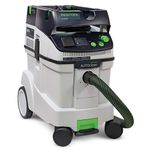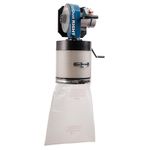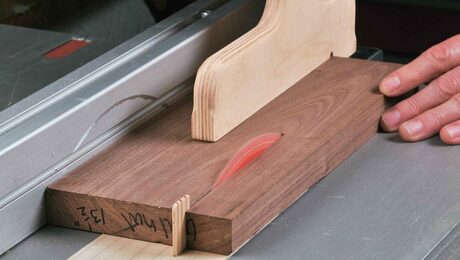Woodworkers’ First Aid (Inventory List and Chart)
You plan to work safely. But do you have a plan if something goes wrong?
Woodworking is inherently dangerous. It says so right in the beginning of each issue of Fine Woodworking magazine. It’s the sort of thing everyone knows.
I could begin with the story of John Woodough who loses a finger on a tablesaw, but that won’t tell you anything you don’t already know. What I want to tell you is what to do in the event of an accident: those cases when you can take care of yourself at home and those times when you need to get to the hospital. Being prepared might save an eye, a finger or a whole lot of blood. And knowing what to do immediately after an accident can help those in the emergency room put you back together.
DOWNLOAD our first-aid kit inventory list and tip sheet to pin up in your shop.
Minor cuts and abrasions
Cleanliness is a relative term. A clean woodshop is still a veritable petri dish of germs and dirt. Barring a serious laceration or amputation, you have to clean any bleeding injury with soap and water to ward off possible infection. Inspect your wound for foreign bodies. If it didn’t grow in you, it’s a foreign body: bits of wood, grit, metal. Remove them by flushing with water. For deeply imbedded grit, you may need to grit your teeth and use a scrub brush. Avoid alcohol or peroxide because both may cause more tissue irritation. To kill germs, it’s better to use a providone-iodine solution, available under many different brand names, such as Betadine. Soap and water works too. Apply an antibiotic ointment to the wound if desired. If bleeding persists, apply pressure to the affected site with a clean gauze pad. When the bleeding stops, cover the small cut or abrasion with a dry, sterile bandage for two to three days.
Check the wound periodically for renewed bleeding or signs of infection, such as increased pain, swelling or redness. Minor swelling and redness is normal in the first day or two. Also watch for red streaks going up your arm or leg or pus drainage. If these occur, you should have the injury evaluated by your doctor. If you have a serious medical condition such as diabetes, which can interfere with healing, you may want to have the wound checked by your doctor. Also, if your last tetanus vaccination was more than 10 years ago, get a booster shot at your next checkup.
For serious injuries: Don’t panic
Pain is your body’s way of telling you something is wrong. And, fortunately, the body’s immediate reaction to pain—roughly the amount of time between flipping a light switch and the light going on—is to remove itself from the offending situation.
The majority of woodworking injuries happen to the hands. The natural reaction when you’ve hurt your hand is to cover it with your other hand, put pressure on the wound and hold both hands to your stomach. But at some point, you have to look at what has happened Of course it hurts, but jumping up and down, yelling words that used to get your mouth washed out with soap, isn’t going to help. Sit down and take a few deep breaths. Sitting down is a good idea for several reasons. It will tend to make you relax, as will the deep breaths, and if looking at the injury is going to cause you to swoon or feel light-headed, you’re less likely to fall down from a seated position. Now, take a look at what has happened.
Lacerations—In addition to the general guidelines given above, you should assess whether a laceration needs to be seen by a doctor. If the cut is spurting blood, there is likely to be an injury to an artery, and you should be seen in the emergency room. To control bleeding, apply pressure with a clean gauze pad. Apply an ice pack to reduce bleeding and pain.
If the bleeding is stopped or is minimal, inspect the wound. If the wound edges come together easily, clean the wound, and apply a bandage. If the edges are somewhat separated, try to bring them together with butterfly closures or adhesive strips. If the laceration is gaping and more than in. deep—the edges do not come together—or if it is on your face, where scarring is less acceptable, you may need stitches. And go to a doctor if you see muscle (it looks like steak), fat or tendons in the wound or if there is a flap of flesh. If the area beyond the laceration is numb, you may have injured a nerve. If you cannot bend the adjacent joints, a tendon may have been injured. If the wound continues to spurt blood or the arm, leg or finger is cold compared to the others, you may have injured the artery feeding that part, and you should go to the emergency room immediately.
Fractures—The most likely fracture (aka, a broken bone) woodworkers experience in the shop is a finger fracture, usually the result of a hammer or a nail gun. Shooting a nail through the bone in your finger is particularly serious because this type of broken bone, called an open fracture, has a high likelihood of infection.
How can you tell when a nail hits bone? Signs include extreme pain, swelling and bruising. Although it may seem strange to list extreme pain, it’s not to people who have done this. They have no problem distinguishing between hitting bone and just flesh. If a nail goes through a joint, get evaluated by a doctor. Another sign of a fracture is not being able to move the joint next to the injury because of pain. If you have any of these signs, go to a doctor to see whether you need an X-ray.
If you whack your finger with a hammer, put some ice on it. I stick my finger in a cup of water filled with ice cubes; it’s easier than holding an ice pack. Check for the fracture signs given above, and if the finger isn’t feeling better, have it checked by a doctor. A common thumb-whacking injury is a bruise under the fingernail; doctors call it a subungual hematoma. Although it looks terrible—and sounds terrible—it only needs draining if it causes such pain that you are unable to go about your business.
Amputations—Let’s face it—this is what we fear most. There’s a scene in Ken Kesey’s Sometimes a Great Notion where Hank Stamper pulls off his gloves, and his wife sees that he’s cut off one of his fingers during work. Macho Hank just keeps working. She’s horrified, and you should be too.
With any complete or partial amputation, the first step is to control bleeding with a pressure dressing. Wrap something clean around the wound, and hold on. Blood loss is a big factor here. An ice pack and elevating the affected site above the level of your heart will also help to control bleeding. Amputations need professional attention, so proceed directly to the hospital. If you can find the amputated part, wash it off, place it in a plastic bag and put the bag on ice. To avoid frostbite, do not put the part directly on ice. The doctors may not be able to reattach it, but the odds go way up if the amputated part is at the hospital and not in the sawdust bin back at the shop.
If you cut off more than a finger, immediately apply pressure to the stump to control bleeding. Don’t panic; keeping cool can save your life. Call for help. If you can, unlock the front door to save time for the paramedics. Sit near the door, or if you feel light-headed, lie on the floor. Don’t worry about the cut-off part; the paramedics will find it.
Eye injuries
The most common eye problems in the shop are from foreign bodies and chemicals. If you get something in your eye, don’t poke at it with a dirty finger. Closely inspect the eye in a mirror or have someone do it for you. If the material is imbedded in the eye, go to the hospital. If the material appears to be floating on the surface of the eyeball, the best thing is to flush it out with eye wash or plain tap water. Hold your eye open so that the water can actually wash out the material. The eye may not feel completely better because it may have been scratched, but if it is feeling better during the day, it should be fine. If the material is still in there, you should have a doctor examine the eye. Also, removing bits of metal should be left to a professional.
Chemical splashes from finishes or strippers can be very damaging to the eye. If a splash occurs, immediately flush the eye under running water for five to 10 minutes. If the eye is still painful or if an alkaline substance like lye, caustic strippers or cement was splashed in the eye, you must be evaluated by a physician. As a general rule, if the eye hurts so much that you can’t open it, go to a doctor at once.
Fumes and dust
Breathing various fumes or dusts can cause illness. Some vapors from finishing products are heavier than air and will collect in our basement workshops unless vigorous efforts, such as exhaust fans and open windows, provide adequate ventilation. If you are working with a finish or solvent and feel dizzy or sleepy, you may be intoxicated by the vapors. Leave the area at once, opening a window or door to the outside as you go.
With the growing popularity and availability of exotic woods comes an increasing incidence of allergic reactions. Repeated exposure to the oils in these woods can cause rashes, but it is possible for the allergy to first manifest itself by breathing problems such as acute asthma or wheezing. The fine dust or the smoke
from machining these woods can trigger an attack. If you find that you are having trouble breathing while working with these woods, stop what you are doing, and leave the area. If you don’t improve or you are struggling to breathe—you can’t get out more than a few words—you should seek medical attention. Over-the-counter asthma inhalers can be tried, but these may not be appropriate if you have high blood pressure or heart disease.
Also, woodworkers are at risk for chemical burns from some strippers that may contain lye or bleaching agents such as oxalic acid. If you come into contact with these materials, immediately flush the affected part with water for at least five minutes. If the area blisters, especially if it involves the face or hands, see a doctor.
What to expect in the emergency room
Forget the television shows where the emergency room doctors and nurses are waiting to solve the day’s problems in less than 50 minutes. Typically, you will be seen by the triage nurse who will determine the priority of your condition. Although a bad cut needing stitches is a big deal to you, it can wait while the patient having a heart attack is seen. Eventually, you will be seen by a doctor who will determine the extent of the injury and whether tests are needed, such as X-rays. If the injury is complex, such as full or partial amputation or severe eye injury, the emergency physician will arrange for consultation with the specialist on call, such as a hand surgeon, plastic surgeon, orthopedic surgeon or ophthalmologist.
Alan Marco, M.D., is an anesthesiologist and a woodworker. His wife, Catherine Marco, M.D., an assistant professor of emergency medicine, assisted in writing this article
Fine Woodworking Recommended Products

Festool Cleantec CT 26 E HEPA Dust Extractor

Rockler Dust Right 1250 CFM

Rockler Dust Right 650 CFM























Comments
One thing that I keep in the shop, in my flyfishing box and fishing vest, is a bleed stopper, or blood coagulator. We get those cuts from really sharp (hopefully) tools that simply don't want to stop bleeding.
Bleed Stop consists of packets of powdered material that stops bleeding almost instantly by causing clotting. Walgreens sells Rapid Seal Wound Seal that works the same but is packaged in a tube the size of a a travel toothpaste tube. I also have some in tubes the size of small superglue tubes, Wound Seal.
This stuff really works - fast. Recently, I was volunteer guiding flyfishing for a veterans group and the vet fell and struck his elbow on a rock, shredding a nice sized place that bled freely (he was using anticoagulants). He was very disappointed that we would have to stop and head back to the car and possibly to the ER. I pulled out a packet of disinfectant and wiped it, then a small tube of Wound Seal, sprinkled it on, put on a bandaid, and we fished for the rest of the day. He was amazed.
Log in or create an account to post a comment.
Sign up Log in